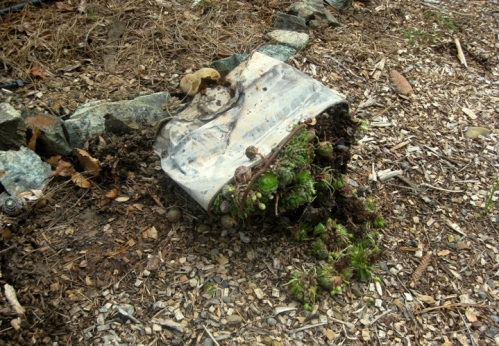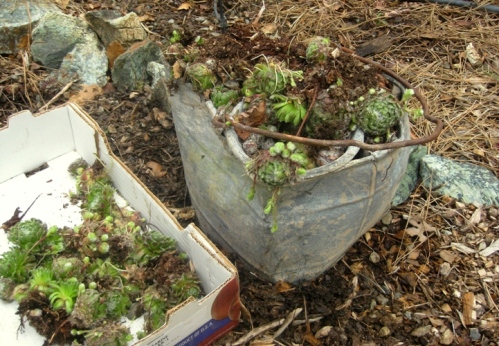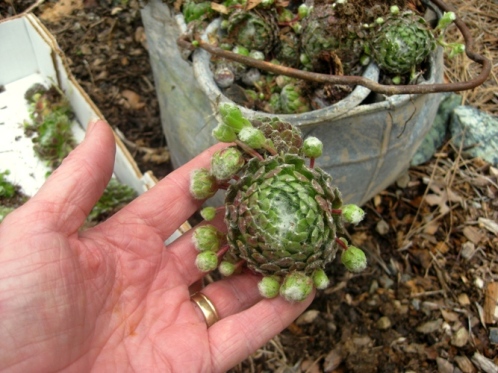Two garden accidents and a happy ending
OK, there are conflicting accounts, but seeing as it is my blog, I will say that the Tractor Man got too close to my container plant.
Tractor Man came in after the accident full of advice for me, primarily to keep my garden further away from his driveway. No defense is needed for my part, so I will decline to show the ‘before’ photos of the driveway and how close it is to the front garden.
Since sempervivum divides easily and this old bucket container was very crowded before, the best solution was to deconstruct the relatively squashed ‘hens and chicks’ and spread them around throughout the garden. I didn’t count how many pieces there were, but it was a lot.
Each rosette was surrounded by ten or fifteen babies. I just left the families united, but you could really have a lot of starts if you wanted from a division like this…hundreds!
You can see that each rosette can easily be stuck into the soil with its single root. Easy peasy… Getting the last few out and …
Oops, when I turned the squished bucket upside down to tap out the soil. It tipped oddly and nipped my hand, showing me that #1, I should have worn gloves working with rusty materials and #2, that I had healthy red blood. Yes, I’ve had a tetanus shot, luckily.
[Gloves or no gloves..? What do you all do? I like getting my hands in the dirt, but accidental brushes with unseen poison oak or cuts and scratches could be avoided most times.]
OK, back to the succulents…
I estimate, sixty or seventy mamas and babies total. They will look great as an edging in this front bed, especially when they bloom.
Sepervivums, meaning ‘Live-forevers’, are very hardy, to 0 degrees F, and are native to Southern Europe and the Mediterranean. These alpine succulents’ native habitat is from 3000-100,000 feet in altitude and there are hundreds of varieties in many colors and shapes. Deer have not touched any of the succulents in my garden, but the ones I brought from Southern California did not survive the cold here. Succulents found at neighbors have worked well and those listed at High Country Gardens website.
This one, arachnoideum, is so named because it looks to have spider webs criss-crossing the top surface of the rosette. The tips of the leaves are connected with thin cobwebby hairs. It’s sometimes called cobweb houseleek. They fill in the spaces they are given and look great growing out of nooks in a wall or in containers.
They can be grown from seed, but are so easy to propagate by my favorite method, ‘stick-it-in-the-ground-and-it-grows’, so why do it any other way?
This is what these Sempervivum look like when in July when in full bloom…
All is well and no real damage done. There is still half the box to plant and maybe some will go into the rock garden after it’s weeded. There is a spot where the granite is actively decomposing where it might feel at home. A southern exposure is what it will like there. The newly planted divisions may not bloom this July, but if they do or when they do, I’ll have an update.
“Of all the Houseleeks neatest far
The jolly Cobweb Houseleeks are.”
-Walter Ingwersen,
1943
Northern California C&S Association
Cactus and Succulent Societies in Southern California
Note: One thing I do use often is Neosporin on my hands when I have any scratches from the garden.
Recent Posts
How to Be a Lazy Gardener
...and still have a pretty garden With a busy household and jobs, we are…
Summer is Spring at Whiskey Falls!
Take a day trip to Whiskey Falls... Come visit Whiskey Falls and the surrounding high…
California oak acorns: Feast or famine
Why do oaks drop more acorns some years and not others? If you have live…
Mule’s ear and Farewell to Spring
Roadside treasures worth stopping for In the first week of July in the Sierra foothills…
Our favorite butterfly plants
Wow! Butterflies love these plants! Grow any of these for instant results and each is…
A water-saving veggie garden for the foothills
Your water-wise veggie garden Does everyone in our Mountain Community grow at least one tomato?…




